BEST Marinara Sauce
This post may contain affiliate links. See my disclosure policy.
Look no further for the BEST Marinara Sauce recipe EVER! You won’t find a more flavorful marinara sauce. It’s easy to make and is absolutely PACKED with flavor! Canning instructions are included so you can enjoy the fresh flavor of tomatoes all year long!

What is Marinara Sauce?
Marinara sauce is a popular tomato sauce that is an essential staple in Italian cuisine. It consists of tomatoes, garlic, onions, olive oil, and a variety of herbs and spices. It’s known for its bright and fresh flavor, is highly versatile, and is a key component in many Italian dishes such as chicken parmesan, eggplant parmesan, pasta alla norma, and spaghetti and meatballs.
Ingredients
It’s hard to beat a simple dish of fresh pasta topped with homemade marinara sauce. The key is using quality products and when you have those these simplest of dishes come to life. The Italians have relied on the best of the best tomatoes for centuries: Sun-kissed San Marzano tomatoes. They’re stronger in flavor and much sweeter than most any other variety. And for that reason it’s hard to replicate the flavor of the marinara sauces you find in southern Italy. Our tomatoes require the help of a few flavor boosts, a dash of sugar being one of them.
This marinara sauce is slow-simmered with a variety of herbs and seasonings for 2 hours. The end result is a delicious sauce you can either eat right away, freeze or can for long-term storage so you can enjoy the vibrancy of Summer all year long! This is the BEST marinara sauce for canning!
I am often asked if you can use fresh onions instead of dehydrated onions. I recommend dehydrated onions for two reasons 1) fresh onions are high in water and can dilute and interfere with the pH level of the tomato sauce (this is not important however if you are not canning the sauce and 2) dehydrated onions are especially suited to canning because their flavor is more concentrated and they contribute a better flavor long-term.
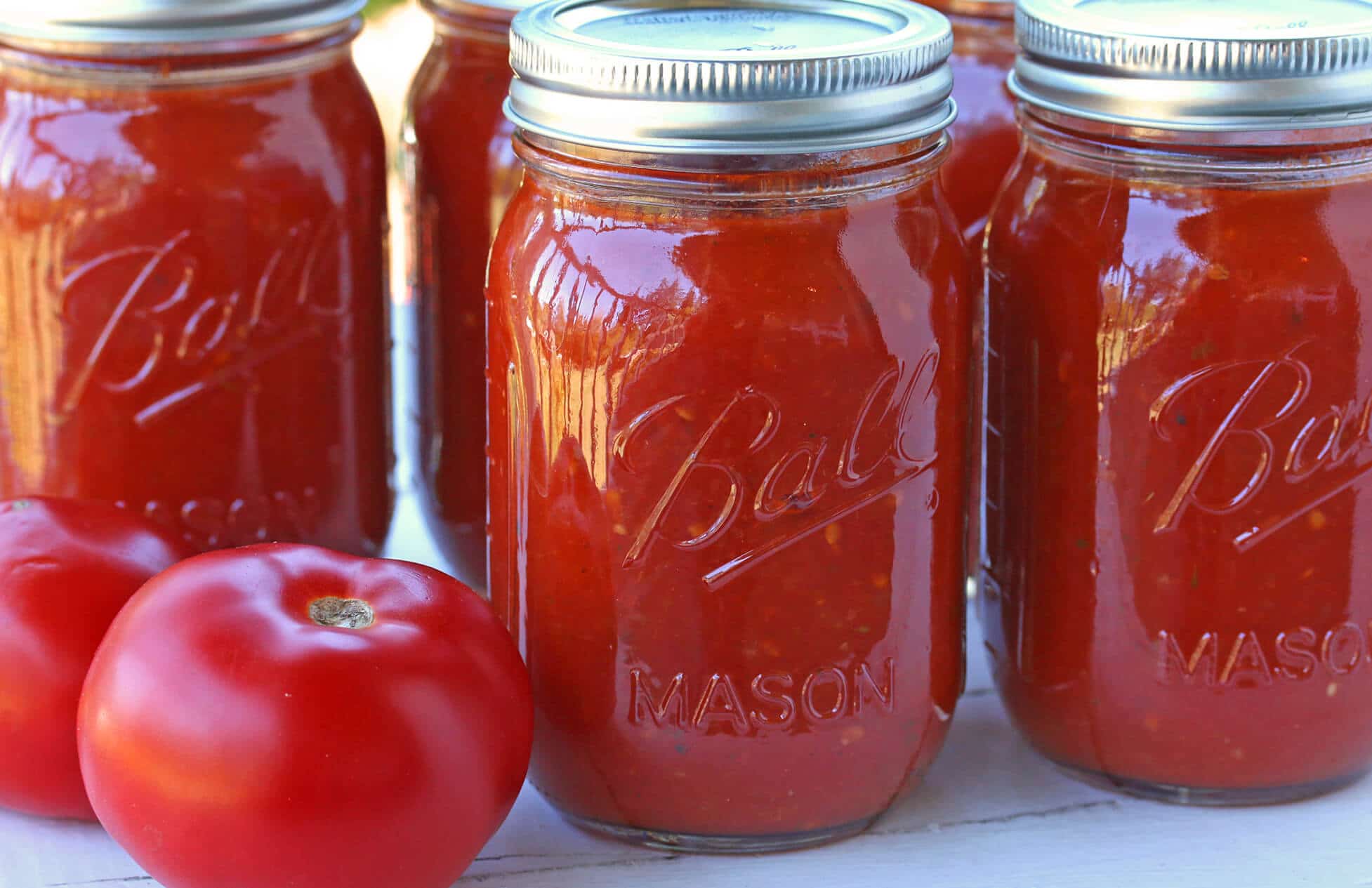
Can You Freeze Marinara Sauce?
Yes, this marinara freezes really well and there is no need to add lemon juice or citric acid. Put the cooled marinara sauce in freezer ziplock bags and lay them flat to take up less space or freeze the sauce in containers. It will keep for up to 6 months. Simply thaw and reheat on the stovetop or in the microwave.
Marinara Sauce Recipe
Select the best tomatoes you can find. The ideal tomatoes are ones that are very meaty with few seeds. Roma tomatoes fall into that category and are the most readily available and they, like other paste tomatoes like San Marzano’s, develop the best flavor when cooked down into a sauce. That said, you can use whatever tomatoes you have available and if they’re grown in your own garden so much the better.
Blanch the tomatoes for a minute in boiling water to loosen the skins. Peel the tomatoes and squeeze out and discard the seeds. Chop the tomatoes.
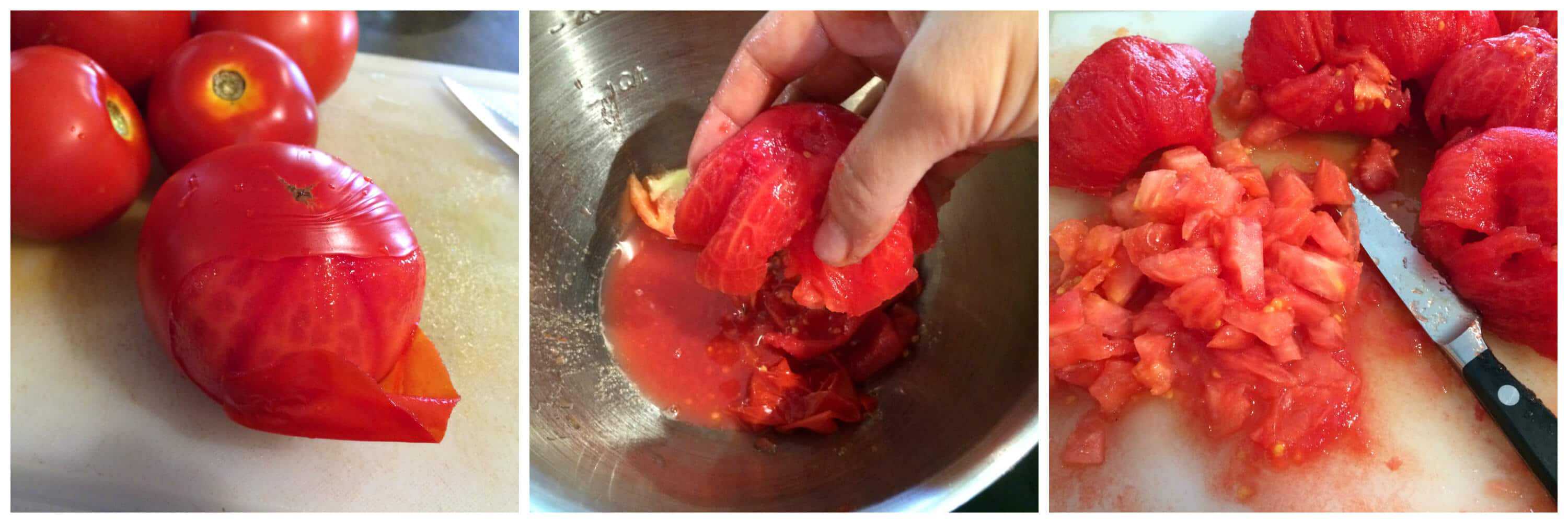
Place the tomatoes in a large pot with all the ingredients (except for the citric acid/lemon juice). Bring it to a boil, reduce the heat to low and simmer, uncovered, for 2 hours, stirring every once in a while. Adjust seasonings to taste. Discard the bay leaves.

Use an immersion blender or transfer to a blender and puree until desired consistency.
I use and recommend Cuisinart’s Immersion Blender, I’ve been using mine for 10 years and it’s still going strong.
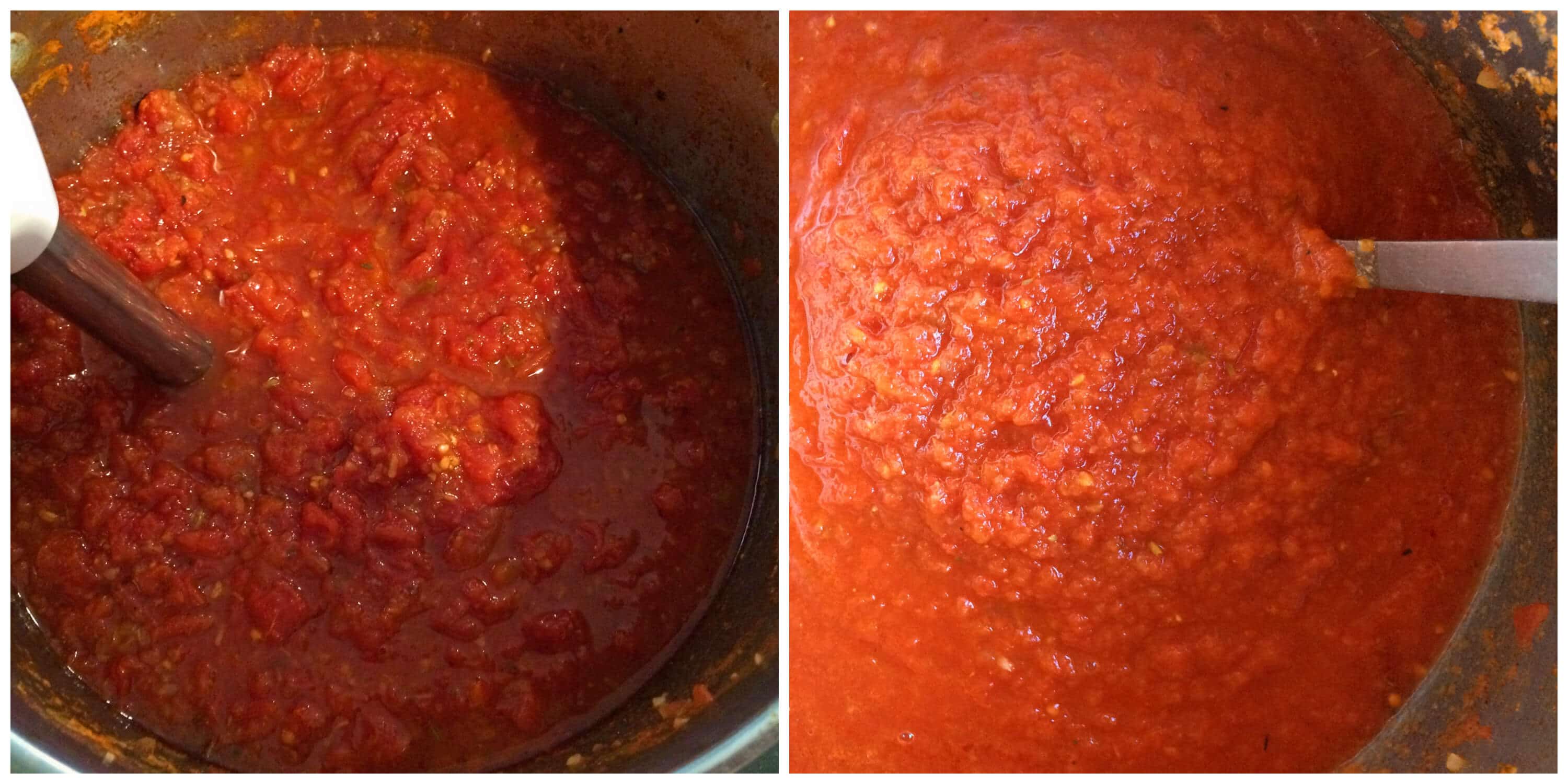
The sauce is ready but the flavor is even better after a day or two.
You can either enjoy the sauce now, freeze it, or can it for future use.

How to Can Marinara Sauce
Before you fill the sterilized jars with the marinara sauce, add 1/4 tsp Citric Acid per pint or add 1 tbsp bottled lemon juice per pint (double those quantities for quarts). This is per USDA guidelines as a requirement for safe canning. Fill the hot marinara sauce into the jars leaving 1/2 inch headspace. Wipe the rims of the jars with a damp cloth. Screw on the clean lids and rims.
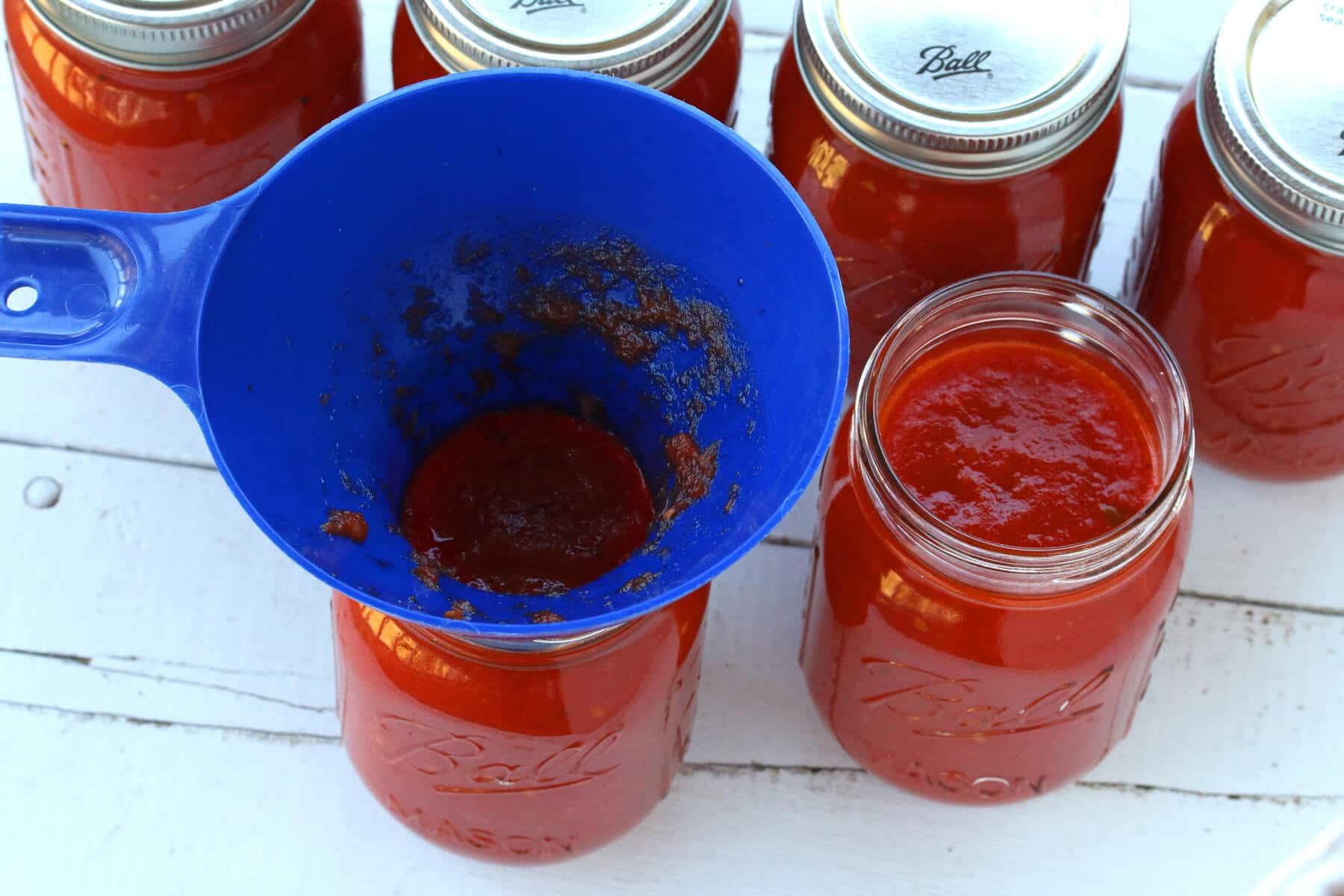
Next you’ll use a water canner to process the jars. This complete canning set has everything you’ll need. Place the jars in the boiling water canning and process for 35 minutes for pints and 40 minutes for quarts (wait for the water to return to a boil before you start the time). Turn off the heat and let the jars rest for 5 minutes before removing.
Adjustments for canning at high altitude:
- At 1,001 to 3,000 feet (305 to 914 meters) above sea level: increase processing time by 5 minutes.
- At 3,001 to 6,000 feet (914 to 1,829 meters) above sea level: increase processing time by 10 minutes.
- Above 6,000 feet (1,829 meters) increase processing time by 15 minutes.
Carefully remove the jars from the water canner and let them sit undisturbed for 24 hours. Check the seals. Stored in a dark, cool place the jars will keep for at least a year but for best flavor use within six months.

Enjoy!

For more fabulous canning recipes be sure to try our:
- Pickled Pepperoncini Peppers
- Pickled Jalapenos
- Pickled Okra
- Dill Pickle Relish
- Giardiniera
- Corn Relish
- Bread and Butter Pickles
- Sweet Pepper and Onion Relish
- Pickled Onions
- Pickled Carrots
- Pickled Banana Peppers
- Pickled Green Beans
- Pickled Asparagus
- Pickled Beets
Save This Recipe
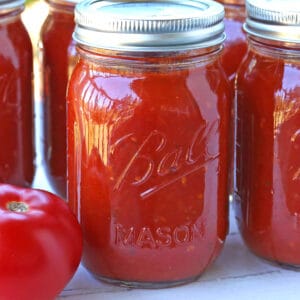
BEST Marinara Sauce
Ingredients
- 12 pounds ripe tomatoes
- 1/2 cup dried/dehydrated minced onion (provides a great flavor boost and is especially suited to canning for long-term storage)
- 6 cloves garlic, minced
- 1/4 cup extra virgin olive oil * omit if canning (see note)
- 3 tablespoons brown sugar
- 2 tablespoons sea salt
- 1 tablespoon dark balsamic vinegar
- 1 1/2 teaspoons dried rosemary
- 1 1/2 teaspoons dried oregano
- 1 1/2 teaspoons dried basil
- 1 1/2 teaspoons dried thyme
- 1 teaspoon crushed fennel seeds
- 1/2 teaspoon dried ground sage
- 1/2 teaspoon freshly ground black pepper
- 2 bay leaves
- citric acid or bottled lemon juice, if canning (per USDA guidelines as a requirement for safe canning)
Instructions
- Blanch the tomatoes for about a minute in a pot of boiling water to loosen the skins. Peel the tomatoes, squeeze out and discard the seeds. Chop the tomatoes.
- Place the chopped tomatoes in a large pot along with the remaining ingredients (except for the citric acid). Bring to a boil, reduce the heat to low and simmer, uncovered for 2 hours, stirring every now and then. Discard the bay leaves. Adjust the salt and pepper to taste. Use an immersion blender or transfer to a blender to puree until desired consistency is reached.You can use the sauce now (flavor gets better in a day or two), freeze it or can it for long-term storage.
- To can the sauce: Place 1/4 teaspoon citric acid or 1 tablespoon bottled lemon juice in the bottom of each sterilized pint-sized jar (double the quantity for quart jars). Ladle the hot marinara sauce into the jars, leaving 1/2 inch headspace. Wipe the rims clean with a damp cloth. Screw on the clean lids and rims. Place the jars in a boiling water canner and process 35 minutes for pints and 40 minutes for quarts. Turn off the heat and let the jars sit for 5 minutes. Remove the jars and let sit undisturbed for 24 hours. Check the seals. Stored in a dark, cool place the jars will keep for at least a year but for best flavor use within six months.Makes approximately 6 pints.
Notes
- At 1,001 to 3,000 feet (305 to 914 meters) above sea level: increase processing time by 5 minutes.
- At 3,001 to 6,000 feet (914 to 1,829 meters) above sea level: increase processing time by 10 minutes.
- Above 6,000 feet (1,829 meters) increase processing time by 15 minutes.
Nutrition
Originally published on The Daring Gourmet September 8, 2017



















I am not a vinegar of any type fan can I omit it or is it absolutely necessary? Planning on using this recipe for my home grown 12 pounds of San Marzanos! Next year I’ll need more plants lol!
Hi Kim, you can omit it but you won’t detect a vinegar flavor if you leave it in – it simply helps contribute to a nice rounded depth to the flavor.
I want to substitute the dried herbs for fresh ones… what would the correct amount be?
TIA
Hi Margot, the conversion for dried to fresh is 1 tablespoon of fresh herbs for 1 teaspoon of dried.
Would I be able to cut the amount of onion in half or would that affect the pH for canning?
Hi Lauren, that’s no problem at all.
Thank you! I am going to try your recipe this weekend but was wondering if you have any other recommendations for a very simple sauce (canning approved) that isn’t heavy on the spices? For example, below is a simple one I found online and really enjoy but it doesn’t say it is canning approved
14 oz can of European tomatoes 3 Tbslp extra virgin olive oil 1/2 tsp sea salt a few pinches of dried oregano 2 or 3 leaves of fresh Italian basil
So…. I’m losing my mind and don’t remember if I put the lemon juice in or not…. if not and they say overnight can I just keep them refrigerated instead of sitting on the shelf for a year?
Lol, I’ve done the same thing before, Chelsea! Yes you can keep them in the fridge but they won’t keep for more than a few days. Instead I recommend pouring the marinara sauce into ziplock freezer bags, lay them flat, and put them in the freezer. They’ll keep for several months that way and you can simply grab and thaw as you need it.
I made this last year and it was gone in no time. Delish !! My question is due to the heat in our area……I would like to freeze it instead of having the stove on. Would you be able to coach me on this process?
Hi Cheri, I’m so glad you enjoyed it, thank you! Do you mean freeze it “raw” without cooking the sauce first? And then proceed with thawing and cooking it later when you’re ready? Yes, I think that’s fine. I would put the sauce in ziplock freezer bags, lay them flat, and place them in the freezer, or use freezer containers, whichever you prefer. It will freeze well for up to several months.
I made this yesterday. There was enough leftover to have for dinner. Delicious! I can’t wait til the middle of winter to taste my garden tomatoes in this sauce. Thank you!
Thank you, Donna, I’m so happy you enjoyed it!
Hello :) Wondering if I can just use regular lemon juice squeezed from a fresh lemon? Thanks!
Hi Patrice, the safety in canning relies on the correct pH level. Fresh lemons vary in their acidity/pH content and so they’re not consistent or reliable, which is why bottled lemon juice is recommend for canning purposes (the pH level is consistent/standard).
Hello! Could I use a food mill to puree, and remove the seeds, of the tomatoes before cooking, eliminating the need for an immersion blender? Thanks!
Hi Kate, you sure can!